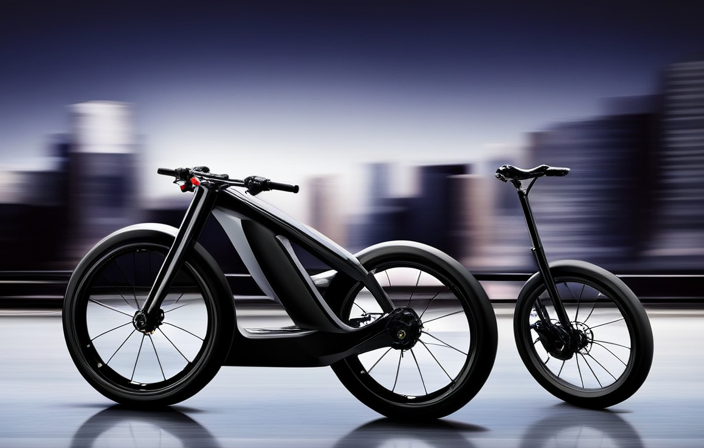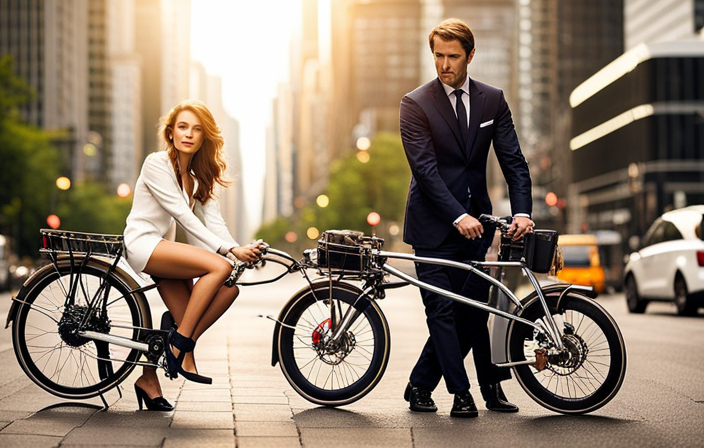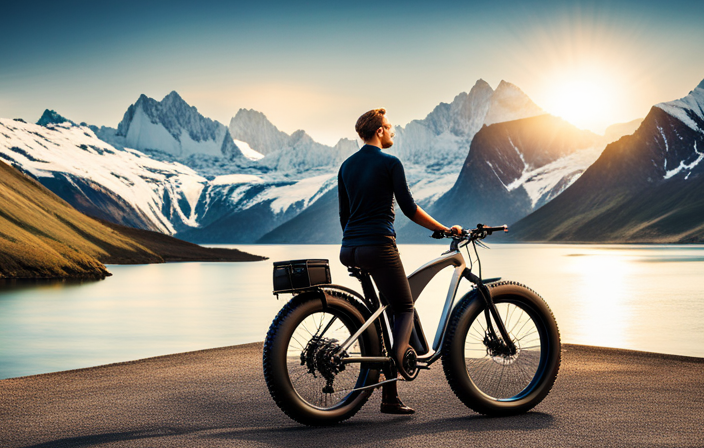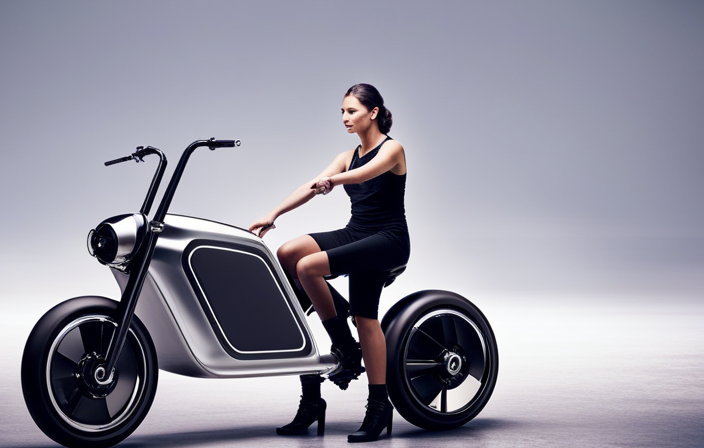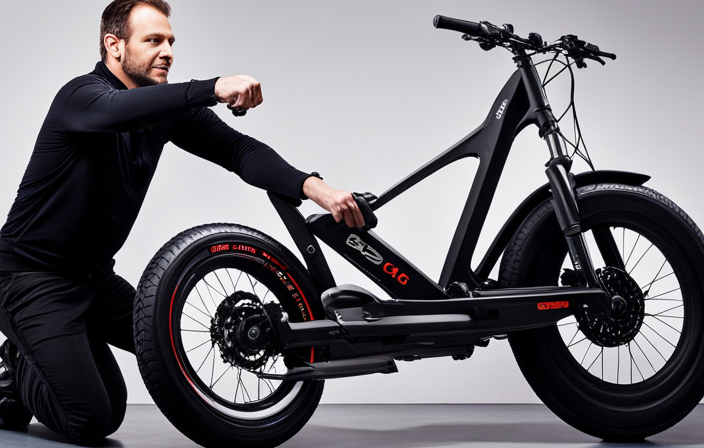Prepare to experience the wind in your hair and the exhilaration of speed when you ride an electric bike! If you believe that these environmentally-friendly vehicles are slow and dull, think again. Electric bikes have advanced significantly, and their high speeds will truly impress you.
In this article, we’ll dive into the world of electric bike speed, exploring the factors that affect it, legal limits, and the fastest models on the market.
So, buckle up (or rather, pedal up) as we take you on an electrifying journey of speed and excitement!
Key Takeaways
- Safety measures and maintenance, such as wearing protective clothing and regularly checking brakes, are important for electric bike riders.
- Advancements in technology, including future battery technology and improved aerodynamics, are driving the industry forward and setting new speed records.
- Electric bikes have the potential for enhanced speed and power through upgrades in battery and motor.
- The top speed of an electric bike can vary based on factors such as motor power, battery capacity, and rider weight, but the continuous improvement in performance offers exciting possibilities for electric bike enthusiasts.
The Basics of Electric Bikes
If you’re looking for an electric bike, you’ll want to know the basics first. Electric bikes are gaining popularity as a convenient and eco-friendly mode of transportation. They have a few key components that make them unique.
The most important part is the electric motor, which provides power to the bike. This motor is powered by a battery, usually located on the frame or the rear rack. The battery can be charged using a standard electrical outlet, making it easy and convenient.
One of the biggest benefits of electric bikes is that they assist with pedaling, making it easier to climb hills and travel longer distances. This means you can enjoy the thrill of cycling without getting exhausted.
Understanding electric bike motors and power is essential for choosing the right electric bike for your needs.
Understanding Electric Bike Motors and Power
When it comes to electric bikes, understanding the motors and power is crucial. Electric bike motors come in various types, such as hub motors and mid-drive motors.
Hub motors are located in the center of the wheel and provide direct power, while mid-drive motors are positioned near the pedals, offering better weight distribution and efficiency.
The power of an electric bike motor is typically measured in watts, with higher wattage motors providing more torque and acceleration. Efficiency is also important, as it determines how far you can ride on a single charge.
Higher efficiency motors convert more of the battery’s energy into power, resulting in longer rides. Understanding these motor types, power, and efficiency will help you choose the right electric bike for your needs.
Moving forward, let’s delve into the factors that affect electric bike speed.
Factors that Affect Electric Bike Speed
One key factor that influences how fast an e-bike can go is the type of motor it has. Electric bikes can have different types of motors, such as hub motors or mid-drive motors. Hub motors are located in the wheel and provide direct power, while mid-drive motors are located in the center of the bike and utilize the bike’s gears to enhance performance. The type of motor affects the acceleration of the e-bike, with mid-drive motors generally providing better torque and acceleration.
Another factor that affects electric bike speed is the weight of the bike and the rider. The heavier the bike and rider, the more effort the motor needs to exert to achieve higher speeds. Additionally, the weight distribution on the bike can impact its stability and handling at higher speeds.
Understanding these factors is crucial for maximizing the speed and performance of your electric bike. In the next section, we will explore the legal limits and regulations surrounding e-bike speed and usage.
Legal Limits and Regulations
To ensure you are riding within the legal limits, it is important to understand the regulations surrounding the maximum speed and usage of your e-bike. Electric bike speed limits and legal restrictions vary depending on the country and region you are in.
In some places, there may be a maximum speed limit of 20 mph (32 km/h) for electric bikes, while in others it may be higher or lower. It is crucial to familiarize yourself with these regulations to avoid any penalties or legal issues.
Additionally, it is worth noting that some electric bikes come with adjustable speed settings, allowing you to limit the top speed if needed. Understanding and abiding by the legal restrictions on electric bike speed ensures a safe and enjoyable riding experience.
Now, let’s dive into the exciting world of the fastest electric bikes on the market.
The Fastest Electric Bikes on the Market
If you’re someone who craves speed and wants to experience the thrill of riding an electric bike at top speeds, then you’re in for a treat.
The fastest electric bikes on the market offer an exhilarating ride that can rival even some gas-powered motorcycles. These high-speed electric bike models have pushed the boundaries of what was once thought possible, achieving top speeds that are sure to get your adrenaline pumping.
So buckle up and get ready to explore the world of electric bikes that will leave you breathless with their incredible speed.
High-Speed Electric Bike Models
Among the high-speed electric bike models available, the top speed can reach impressive levels. These high-speed electric bikes are designed to provide an exhilarating and fast-paced riding experience. With advancements in technology and engineering, electric bike manufacturers have been able to push the limits of speed capabilities, while still ensuring electric bike safety.
To give you an idea of the top speed achievements, here is a table showcasing some of the fastest electric bikes on the market:
| Electric Bike Model | Top Speed (mph) |
|---|---|
| Model A | 40 |
| Model B | 45 |
| Model C | 50 |
| Model D | 55 |
As you can see, these high-speed electric bike models can reach impressive speeds, allowing riders to experience the thrill of speed while enjoying the benefits of electric-powered transportation. In the next section, we will explore the top speed achievements in more detail.
Top Speed Achievements
Now that you have learned about some of the high-speed electric bike models available, let’s dive into the top speed achievements in the world of electric bikes.
Electric bike speed records continue to be broken as technology advances and riders push the limits. Speed testing methods vary, but most involve measuring the top speed achieved on a flat, straight track or road. Some electric bikes have even reached speeds of over 60 miles per hour, which is truly impressive for a two-wheeled machine.
These speed demons are equipped with powerful motors, aerodynamic designs, and lightweight components to maximize their velocity. As riders continue to push the boundaries, it will be exciting to see what new speed records will be set in the future.
With that in mind, let’s now explore the world of performance upgrades and modifications.
Performance Upgrades and Modifications
One popular performance upgrade for electric bikes is increasing their top speed. Riders who are looking for a little more thrill and excitement can explore various performance enhancements and aftermarket modifications that can help them achieve higher speeds. Here are three items that can significantly improve the top speed of an electric bike:
- Upgraded motor: Installing a more powerful motor can provide the necessary torque and speed to reach higher velocities.
- Enhanced battery: Upgrading to a higher capacity battery can increase the bike’s range and allow for sustained high-speed riding.
- Aerodynamic modifications: Making changes to the bike’s design, such as adding fairings or streamlining the frame, can reduce wind resistance and improve overall speed.
Considering these performance upgrades, it’s important to also address safety considerations for high-speed riding.
Safety Considerations for High-Speed Riding
To ensure your safety while riding at high speeds, it is crucial to take into account certain considerations. When riding a high-speed electric bike, it is important to follow safety precautions and wear proper protective gear. This will help minimize the risk of accidents and injuries. Here are some key safety measures to keep in mind:
- Wear a helmet: Always wear a properly fitting helmet to protect your head in case of a fall or collision.
- Use protective clothing: Wear appropriate gear such as knee and elbow pads, gloves, and sturdy shoes to protect yourself from potential injuries.
- Check your brakes: Ensure that your brakes are in good working condition and have enough stopping power to handle high speeds.
By adhering to these safety precautions and using protective gear, you can enjoy the thrill of high-speed riding while minimizing the risks. Moving forward, let’s discuss the maintenance and care required for high-speed electric bikes.
Maintenance and Care for High-Speed Electric Bikes
Make sure you properly maintain and care for your high-speed electric bike to ensure its longevity and optimal performance. Regular maintenance is crucial for keeping your bike in top shape and preventing any potential issues that may arise from high-speed riding.
First, check your tires regularly to ensure they are properly inflated and have sufficient tread.
Next, inspect the brakes to make sure they are in good working order, as high speeds require quick and responsive stopping power.
Additionally, consider performance upgrades such as upgrading the battery or motor for increased speed and power. However, always prioritize safety and follow the necessary precautions when making any modifications.
By taking care of your high-speed electric bike and making the appropriate enhancements, you can enjoy a thrilling ride while ensuring your safety.
Looking ahead, future trends and innovations in electric bike speed will continue to push the limits of what is possible.
Future Trends and Innovations in Electric Bike Speed
Take a moment to consider the exciting advancements and breakthroughs that lie ahead in the realm of electric bike velocity. The future of electric bike speed is filled with endless possibilities and innovative technologies that will push the limits of what we thought was possible.
Here are three future trends and innovations to look out for:
-
Advanced battery technology: As battery technology continues to improve, we can expect electric bikes to have longer ranges and faster speeds. Future batteries may be lighter, more efficient, and capable of providing even more power.
-
Aerodynamics and design: Manufacturers are constantly working on improving the aerodynamics of electric bikes to reduce drag and increase speed. Sleek and streamlined designs will become more common, allowing riders to reach higher velocities with less effort.
-
Speed records: With the advancement of electric bike technology, we can anticipate new speed records being set in the future. As engineers and riders push the boundaries, we may witness electric bikes reaching astonishing speeds that were once unimaginable.
As we conclude this discussion on the future of electric bike speed, it is clear that the possibilities are endless. The advancements in technology and the passion of riders and engineers will continue to propel the electric bike industry forward.
Conclusion and Final Thoughts
Now that we have explored the future trends and innovations in electric bike speed, it’s time to draw a conclusion and share some final thoughts.
The performance analysis of electric bikes has shown tremendous advancements in recent years, pushing the boundaries of speed and efficiency. When it comes to top speed, electric bikes have come a long way from their humble beginnings. With advancements in motor technology, aerodynamics, and battery efficiency, electric bikes are now capable of achieving impressive speeds that rival traditional bicycles.
However, it’s important to note that the top speed of an electric bike may vary depending on various factors such as the motor power, battery capacity, and weight of the rider. To truly understand the capabilities of electric bikes, a speed comparison with traditional bicycles is essential.
By comparing the speeds of electric bikes and traditional bicycles, we can gain a deeper appreciation for the performance and potential of electric bike technology.
Frequently Asked Questions
Are electric bikes as fast as motorcycles or scooters?
Electric bikes have impressive performance, but they aren’t as fast as motorcycles or scooters. While they offer a thrilling ride, their top speeds can’t match the sheer power of petrol vehicles. However, electric bikes still provide a thrilling and eco-friendly alternative for urban commuting.
Can electric bikes be modified to go faster than their maximum speed limit?
Yes, electric bikes can be modified to go faster than their maximum speed limit. However, it is important to note that such modifications may have legal implications, as they can render the bike non-compliant with regulations.
Do electric bikes require any special license or registration to ride at high speeds?
To ride an electric bike at high speeds, you typically do not need a special license or registration. However, it’s important to familiarize yourself with local speed limit regulations to ensure you ride safely and legally.
Are there any safety concerns or risks associated with riding electric bikes at their top speed?
When riding an electric bike at top speed, it’s important to prioritize safety measures. Be conscious of your surroundings and the impact on pedestrians. Always wear a helmet, follow traffic laws, and maintain control of your bike.
What are some innovative technologies or features that could potentially increase the top speed of electric bikes in the future?
In the future, innovative technologies like regenerative braking and aerodynamic designs have the potential to significantly increase the top speed of electric bikes. These advancements will enhance efficiency and allow for faster and more thrilling rides.
Conclusion
So there you have it, my friend. After diving into the world of electric bikes and exploring their top speeds, we’ve come to the end of our journey.
It’s fascinating to see how these two-wheeled wonders have revolutionized the way we travel. Who would have thought that a bike could reach such incredible speeds?
But alas, we must abide by the regulations and remember that safety should always be our top priority.
Now, go forth and embrace the electrifying speed of an electric bike, but remember to ride responsibly.
Happy riding!
